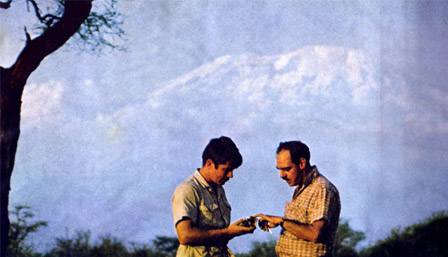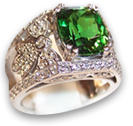Tanzanite
In the late 1960’s as Tiffany and Co.’s official consultant geologist on Tanzanite, Campbell Bridges was instrumental in the introduction of Tanzanite to the United States. His passion for the geology of Africa brought him to Tanzania during the time that the Tanzanite belt was being discovered, where he explored the mystery of this beautiful African gemstone.

May 1969 Life Magazine photo of Campbell Bridges examining Tanzanite under the gaze
of Kilimanjaro.
When I bought my first samples of blue zoisite (Tanzanite), no one knew exactly what mineral it was. In fact, the person from whom I first purchased the samples believed it to be sapphire. Because of its hardness of around 6 ½ and its strong trichroism, I suspected it was zoisite. Thus, in 1967 as I was on my way to the U.S. with my fiancé to meet my future in-laws, I took this sample which I believed to be zoisite to show to Burt Krashes and Robert Crowningshield, both senior staff members at the Gemmological Institute of America’s New York office. Though they had never seen gem quality blue zoisite before, they confirmed my suspicions.
Shortly thereafter, I also showed the blue zoisite crystal to Henry B. (Harry) Platt, who was at the time Vice President of Tiffany and Company. Platt was impressed by its potential, believing that it could be a less expensive sapphire substitute when cut and polished. He encouraged me to follow up on its availability. (Platt later named it Tanzanite after its country of origin).
I then took the blue zoisite crystal to the Smithsonian Institution to show Dr Paul Desautels, then Assistant Curator, later to be Curator. He also had not seen gem blue zoisite before and was so enthusiastic about this new find that he decided to acquire it for the Smithsonian’s mineral collection.
On my next trip to Tanzania the rush for Tanzanite was in full swing. I visited the claims of Emmanuel DeSouza, the man most people credit with the discovery of Tanzanite, Costas (Lucky) Papanicolou, whose claims lay just south of DeSouza’s, followed further to the south by those of the Tsakiris brothers, and even more southerly were those of the Sideras family. To the north of DeSouza, claims were mined by Ali Juyawatu, a former game warden from the Umba region in north-eastern Tanzania.
In due course Platt and I went to Tanzania together and Tiffany’s made a contract to purchase and market Tanzanite with Tanzania Gemstone Industries (a government sponsored company). I became Tiffany’s consultant for this new gemstone until the contract was broken when a German consortium offered Tanzania Gemstone Industries (TGI) more for it.
As Tsavorite and Tanzanite are very similar in chemical formula, they frequently occur together. Gem Tanzanite forms at lower temperatures than Tsavorite, thus, if it is associated with the higher temperatures needed to form gem Tsavorite, the Tanzanite is often cracked. Although I mine Tanzanite on my claims in Kenya, it does not occur in sufficient quantity, as yet, to be economical. Merelani in northern Tanzania remains the major source for Tanzanite.


